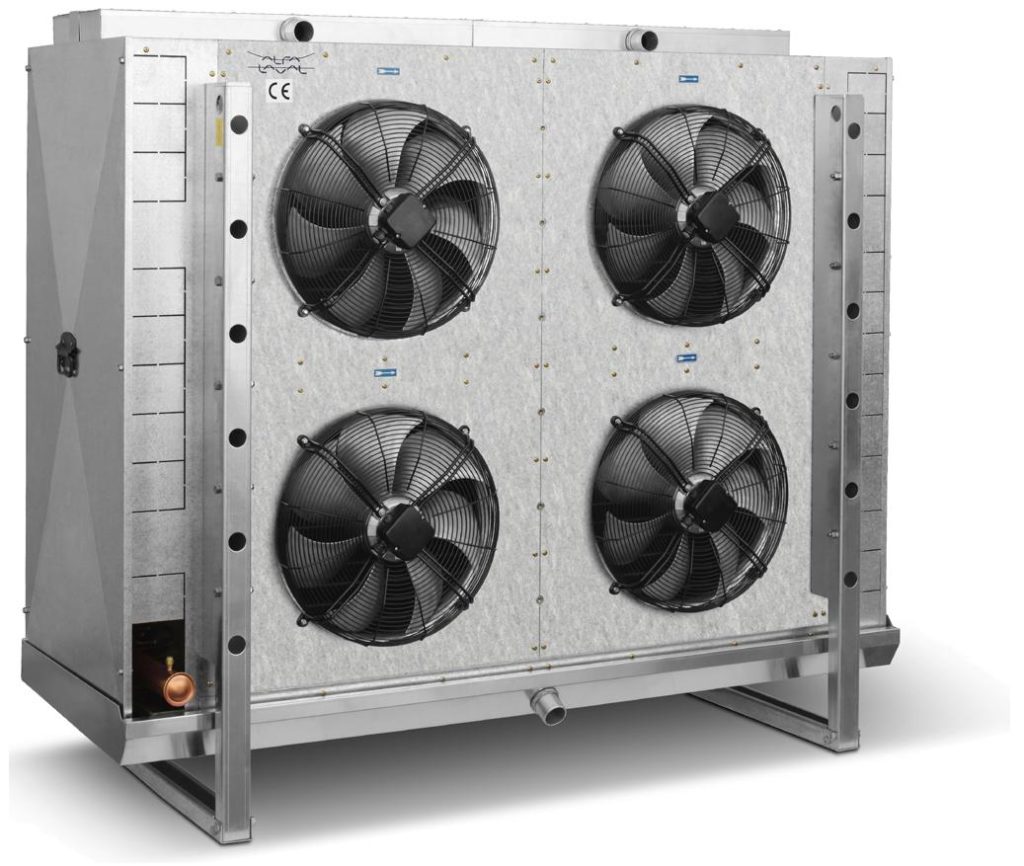Condensers make use of a condensing medium, such as air or water, that absorbs heat from a vapor. As the vapor loses its heat to the condensing medium, its temperature falls to the saturation point, and it condenses to a liquid. The table of contents below link to different types of condensers. Each type of equipment usually has sections on general information, information about equipment design, usage examples, and advantages/disadvantages.

Air Cooled
Air cooled condensers use air as the cooling medium. They are the most used type of condensers.
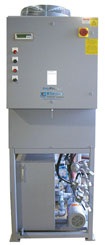
General Information
Air cooled condensers use circulating air to cool hot gases. In most large models, a fan is used to either push or pull the air through the condenser. Smaller models, however, usually depend on gravity to circulate the air.
Equipment Design
The hot vapor to be condensed travels through a series of finned copper tubes. Fans force air to circulate around the tubes, and this air removes heat from the vapor. The resulting condensate drips down the tubing into a reservoir or out a drain.
Condensers can be designed for one or two stages, as shown on the left. While the two-stage condenser is more efficient, it is also more expensive.
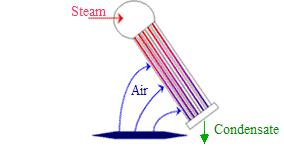
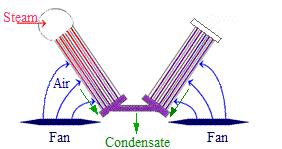
Usage Examples
Condensers are used in power plants to condense exhaust steam from turbines. They are also used in refrigeration plants to condense refrigeration vapors such as ammonia or fluorinated hydrocarbons. They are used in the petroleum and chemical industries to condense a variety of chemical vapors. The air cooled condensing unit shown below is a chilling system used for ice and curling rinks.

The condenser shown below has a “V-type” design that is used in refrigeration and air-conditioning installations. This condenser has aluminum fins, and the optimized V shape results in excellent heat transfer with minimized refrigerant charge.
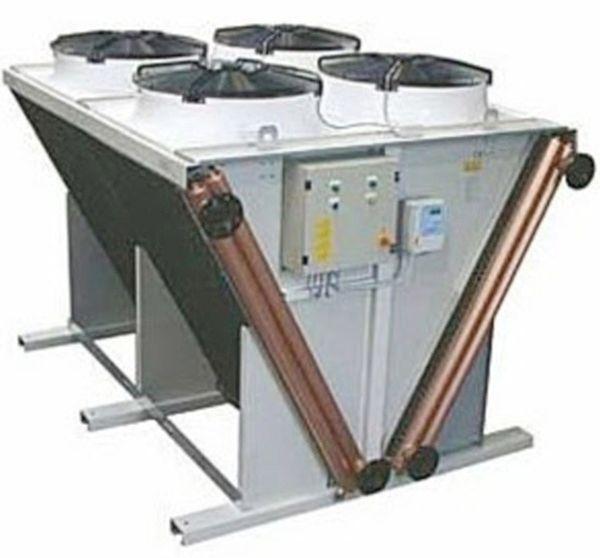
Advantages
- Easy to install.
- Requires no water.
- Condensing medium, air, will not freeze.
Disadvantages
- As water condenses, it has the risk of freezing at low operating temperatures.
- Adequate supply of fresh air required.
- Fan may be loud in large operations.
- Changes in air temperature may cause the condensing pressures to fluctuate.
Water Cooled
This section discusses water-cooled condensers, such as the one shown here.
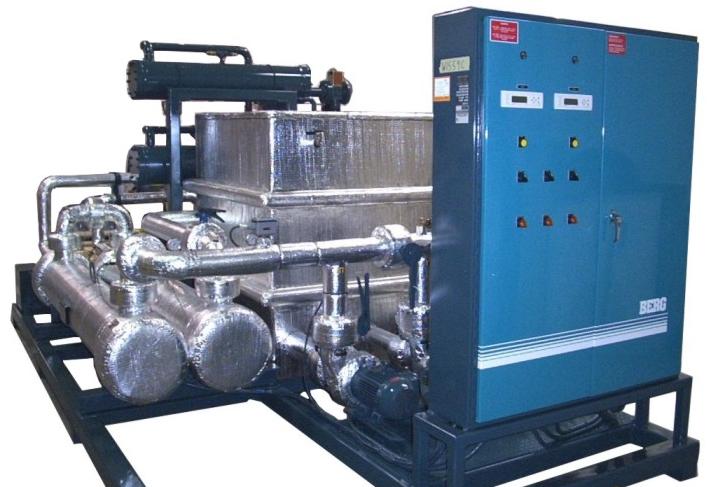

General Information
In most water-cooled condensers, the water runs through tubing or coils in a sealed shell. The hot vapor that is to be condensed is released into this shell (above right).
Equipment Design
The water-cooled chillers shown below use an evaporator to remove heat from the process and then use a water-cooled condenser to remove the heat from the evaporator. Water conducts heat better than air, making water-cooled condensers smaller, cheaper, and able to consume less energy per horsepower than air-cooled condensers.
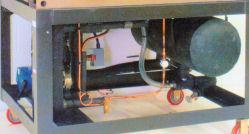

Usage Examples
Water-cooled condensers require an adequate supply of fresh water and are used in power plants to condense exhaust steam from turbines, in refrigeration plants to condense refrigeration vapors such as ammonia or fluorinated hydrocarbons, and in the petroleum and chemical industries to condense a variety of chemical vapors.
Advantages
- Lower condensing pressures than air-cooled condensers.
- Better control over condensing pressure.
- Since water has excellent heat transfer characteristics, water-cooled condensers are more compact than air-cooled condensers.
Disadvantages
- Excessive water velocities or cavitation inside the condenser tubes can damage condensers.
- At low operating temperatures, condensing medium and condensate may freeze.
Evaporative
General Information/Equipment Design
Evaporative condensers are used when the water supply is insufficient to operate a water-cooled condenser, or when the condensing temperature is lower than air-cooled condensers can achieve. A water/air mixture, the coolant, is sprayed into a chamber through which the hot vapor passes. As these substances come in contact with each other, the water quickly evaporates. The loss of this heat of vaporization causes the vapor feed to condense. This process requires much less cooling water than water-cooled condensers, making evaporative condensers practical for hot, arid regions.
Advantages
- Water consumption is only a fraction of that in water-cooled condensation.
- Condensing temperatures are close to the wet bulb temperature.
Disadvantages
- The water may freeze at low operating temperatures.
- Impurities in the vapors may cause corrosion.
- A small amount of the cooling water must be continually purged to prevent the build-up of contaminants.
Acknowledgements
- Alfa Laval, Richmond, VA
- BERG Chilling Systems Inc., Toronto, ON
- Dimplex Thermal Solutions, Kalamazoo, MI
- First Choice Chillers, Markham, Ontario: now, Temperature Corporation
- SPX Cooling Technologies, Overland Park, KS
References
- “Condensers” The New Encyclopedia Britannica, Inc., Volume 3, 15th ed. Chicago, Illinois, 997. p. 521. Print.
- Elliott, Thomas C. “Air-Cooled Condensers”, Power. Jan. 1990. Print.
- Jennings, Burgess. “Condenser.” The Encyclopedia Americana: International Edition. Grolier, Inc. Danbury, CT, 1996 p. 519. Print.
- Larinoff, Michael W. “Can Your Air-Cooled Condenser Handle the Big Chill?” Power. Jan./Feb.,1997. Print.
- The New Encyclopedia Britannica, Inc., Volume 3,15th ed. Chicago, IL, 1997. p. 521. Print.
Developers
- Maureen Hindelang
- Joseph Palazzolo
- Matthew Robertson
- Kelsey Kaplan
- Keith Minbiole

